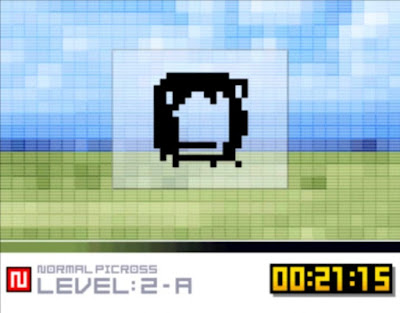I have only ever come across this form of puzzle through watching YouTube solves of this kind of puzzle merged with Sudoku, which strikes me as fiendishly difficult and easily above my capabilities. But Picross DS isn't that diabolical. It's just drawing little pictures, as directed by a puzzle.
Fun Times
The tutorial I'm greeted with before emulating Picross DS is all you and I need to get going. Numbers tell you how many adjacent blocks in a row or column are filled in, figure out which blocks are filled in to complete a little picture, in this case, a dog that gets coloured and animated and runs around like a little .gif. Adorable.
The idea is that you can solve every grid logically, without resorting to guesswork. Indeed, mindlessly jabbing the touchpad with your stylus will result in penalty minutes be applied to your completion time, and if you spend longer than an hour on a single puzzle, you're timed out and have failed to fill in whatever it was that you're drawing.
And boy, did some of the later levels in the introduction set give me some head-scratchers. It's amazing how late in the day - i.e., when they're being coloured and animated - that you realise what it is that you've been drawing. If I tell you that these two were a mailbox and a pencil, you can see a mailbox and a pencil, but I was struggling until the very last piece of the puzzle was placed until I could see what I was doodling.
I suppose the reverse of that would be that if you had an idea of what it is you're working towards, you could make reasonable guesses at the squares that need to be filled it and ignore the puzzle aspect of Picross, but you do have to start somewhere, and that starts with the puzzle.
Advancing through the difficulty levels, there's a whole batch of fruit to worm your way through, accompanied by an apple-themed colour palette, though it is optional. It doesn't really help you work out whether a square is to be filled in or not, it just looks a bit nicer.
What does help you start to crack the puzzle, however, is the hint system, which will fill in one row and one column for you before you begin, and when the animal section started with its monstrously sized grids, you can bet I was relying on a helpful start more often than not.
Frustrations
These 15x15 grids work in exactly the same way as the smaller grids, save for the fact that you now have to zoom into the grid to even place a mark on it, and to navigate this up-close view requires you to touch the pan tool to move the view before switching back to either the pen or X tool to make a mark.
Forget to switch tools and you may end swiping a whole load of boxes in a row incorrectly, or otherwise get lost in the grid despite Picross' best efforts at keeping useful information displayed and highlighted for you.
Similarly, if you know an outer clue is '3', but you know from previous markings that one particular cell can't be filled in, and if that cell is impossible the two below it aren't big enough to fit three cells into, then you can cross them out and look for a group of three further up.
Where a given clue points to is all revealed in the logic, and the more you play Picross, the faster you spot the logic and the more you learn about how it all works.
Oh, look, it's a lion. Of course it is. Makes sense now, doesn't it? Again, didn't take 50 minutes to finish, but then some people may well struggle with challenging images for that kind of length of time. I guess it all depends how you fare with the earlier, easier levels.
 |
| Rawr |
Final Word
I played through a few sections of Picross DS, and there are some other mini-games to test your stylus accuracy, but they're definitely not what you come to Picross DS for. No, the reason you play this game is to have a go at a logic puzzle that will reward you with a little animated image of an animal, or some fruit, or a mailbox, whatever it is you've spent ten, twenty minutes trying to figure out.
And because it was fun to see that little .gif, you forget about all the time it took you to get there and you think "Yeah, go on, one more", and you get stuck playing Picross DS for another hour. No lie, I want to do a few right now.
It's a mental distraction. I usually go for a Sudoku but that's because I haven't found a Picross website, and I haven't found one of them because I haven't looked for one. But next time RetroArch gets opened, and I cycle through to the history tab, and I see Picross DS in the recently played list...
Logic puzzles can put people off, especially if they inadvertently throw themselves into the deep end when trying one for the first time. The ease of introduction to the puzzle that Picross DS takes makes it an ideal starting point for anyone interested in the idea of drawing in this weird puzzly way. It's friendly, it's colourful, it's got animals, what more do you want?
Will it keep me hooked for days or just hours? Doesn't matter. While it's hooked me, it's a fun little puzzle to occupy my brain with. Lovely.
Fun Facts
Arguments can rightly be made regarding the replay value of the game being rather low/non-existent, but daily challenges and alternative puzzles can be found to put a twist on the formula and keep you playing.
Picross DS, developed by Jupiter, first released in 2007.
Version played: Nintendo DS, 2007, via emulation.























